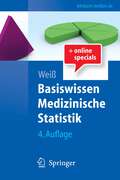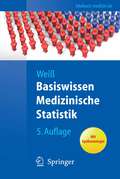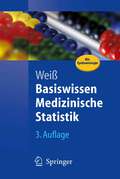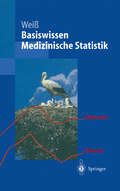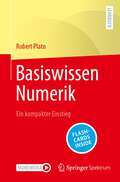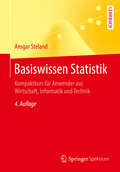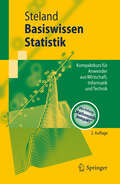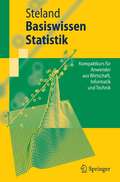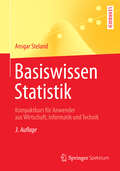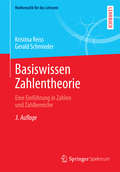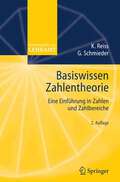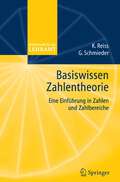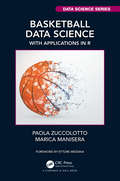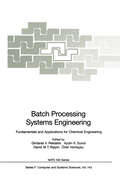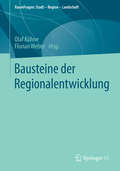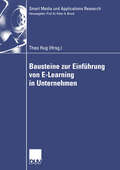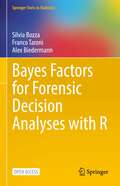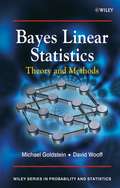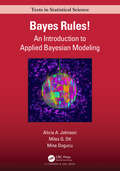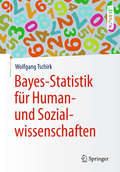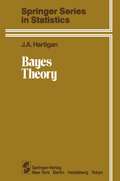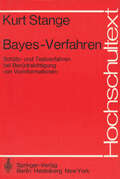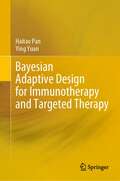- Table View
- List View
Basiswissen Medizinische Statistik (Springer-Lehrbuch)
by Christel WeißIn 16 Lerneinheiten sicher zur Prüfung. Sämtliche Inhalte sind auf das Wesentliche reduziert und verständlich erklärt – von den Grundlagen bis hin zur Doktorarbeit, von Häufigkeiten bis hin zu Diagnostik-Studien. Ausführliche Rechenbeispiele, "Merke-Boxen" und Herleitungen zeigen Ihnen, wie Sie die Medizinische Statistik anwenden und Ergebnisse aus Studien und Untersuchungen überprüfen. Das Englisch-Deutsch-Glossar hilft Ihnen dabei, die Statistiksoftware zu verstehen. Bonusmaterial zur 4., überarbeiteten Auflage finden Sie unter www.lehrbuch-medizin.de – ein ausführliches Lexikon, Übungsfragen, Original-Prüfungsfragen, Kurzzusammenfassungen.
Basiswissen Medizinische Statistik (Springer-Lehrbuch)
by Christel WeißVorwort zur fünften Auflage Es gibt keine gute Medizin ohne Biostatistik. Dieser Satz wird m- licherweise bei manchen Medizinstudenten auf Unverständnis s- ßen. Warum sollte sich ein Arzt mit Biostatistik befassen, und - rum ist dieses Fach Teil der ärztlichen Ausbildung? Die Antwort ist einfach: Medizinische Forschung ist ohne Statistik nicht möglich. Ärztliches Handeln muss auf Wissen basieren. Ansonsten verfallen wir Zufällen und Halbwahrheiten, die auch dadurch nicht besser werden, dass sie mantrahaft wiederholt werden. Dies wäre unter ethischen, medizinischen und ökonomischen Aspekten nicht v- tretbar. Ist Biostatistik unattraktiv? Keineswegs! Viele Mediziner finden dieses Fach sogar faszinierend. Erst eine statistische Analyse erm- licht es, Daten zu strukturieren, Zusammenhänge aufzudecken und abzusichern, Ergebnisse zu interpretieren und die daraus result- renden Erkenntnisse in die Praxis umzusetzen. Jeder Arzt, der w- senschaftliche Publikationen liest oder selbst erstellt, weiß dies. Den meisten Studenten wird dies spätestens beim Schreiben ihrer D- torarbeit bewusst. Der schlechte Ruf, der diesem Fach vorauseilt, ist dadurch begründet, dass statistische Methoden auf mathematischen Formeln basieren, die für manche ein Gräuel sind. Als Anwender muss man diese Formeln jedoch nicht herleiten können oder gar auswendig lernen (zumal die Berechnungen üblicherweise von einer Software durchgeführt werden). Man sollte vielmehr verstehen, wie statistische Methoden sinnvoll in der Medizin angewandt werden. Jedem, der diesem Fachgebiet unbefangen begegnet, erschließen sich äußerst interessante Anwendungsmöglichkeiten.
Basiswissen Medizinische Statistik (Springer-Lehrbuch)
by Christel Weiß Peter BucskyVorwort zur dritten Auflage Es gibt keine gute Medizin ohne Biostatistik. Dieser Satz wird m- licherweise bei einigen Medizinstudenten auf Unverständnis stoßen. Warum sollte sich ein Mediziner mit Biostatistik befassen, und - rum ist dieses Fach Teil der ärztlichen Ausbildung? – Ärztliches Handeln muss auf Wissen basieren. Ansonsten verfallen wir Zufällen und Halbwahrheiten, die auch dadurch nicht besser werden, dass sie mantrahaft wiederholt werden. Dies wäre unter ethischen, medi- nischen und ökonomischen Aspekten nicht vertretbar. Medizinische Forschung ist ohne Statistik nicht möglich. Ist Biostatistik unattraktiv? Keineswegs! Es gibt sogar Mediziner, die dieses Fach faszinierend finden. Erst eine statistische Analyse erm- licht es, Daten zu strukturieren, Zusammenhänge aufzudecken und Ergebnisse zu interpretieren und in der Praxis anzuwenden. Der schlechte Ruf, der diesem Fach vorauseilt, ist dadurch begründet, dass statistische Methoden auf mathematischen Formeln basieren, die für manche ein Gräuel sind. Als Anwender der Statistik muss man diese Formeln jedoch nicht herleiten können oder gar ausw- dig lernen (zumal die Rechnungen üblicherweise mit einer geeig- ten Software durchgeführt werden). Man sollte vielmehr verstehen, wie statistische Methoden sinnvoll in der Medizin angewandt w- den. Jedem, der diesem Fachgebiet unbefangen begegnet, erschl- ßen sich äußerst interessante Anwendungsmöglichkeiten. Ziel dieses Buches ist es deshalb, Studenten und interessierten Ä- ten einen kompetenten Überblick über statistische Anwendungen in der Medizin zu geben. Das Buch ist breit angelegt. Es ist deshalb nicht nur Studenten bei den Examensvorbereitungen nützlich, s- dern auch als Nachschlagekompendium geeignet. Manche - schnitte behandeln Themen, die über die Anforderungen des Basis-
Basiswissen Numerik: Ein kompakter Einstieg
by Robert PlatoDieses Lehrbuch vermittelt grundlegende Kenntnisse zu den wichtigsten Themen der numerischen Mathematik. Dazu gehören jeweils Algorithmen, Fehlerabschätzungen und Fragen der arithmetischen Komplexität. Zahlreiche kleine Anwendungsbeispiele, Abbildungen, Pseudo-Codes, numerische Illustrationen und einfache Rechenbeispiele unterstützen die Lektüre. Das Lehrbuch ist sowohl als Begleittext für einführende Vorlesungen über Numerik als auch im Selbststudium einsetzbar. Auf die Präsentation von Beweisen mathematischer Aussagen wird größtenteils verzichtet. In der Springer Nature Flashcards-App stehen circa 140 Multiple-Choice- und Lückentext-Fragen zur Verfügung, mit der die erworbenen Kenntnisse überprüft werden können. Zielgruppe: Studierende und Hochschulabsolvierende der Natur- und Ingenieurwissenschaften sowie der Mathematik und Informatik an Universitäten und Fachhochschulen.
Basiswissen Statistik: Kompaktkurs für Anwender aus Wirtschaft, Informatik und Technik (Springer-Lehrbuch)
by Ansgar StelandIn diesem Buch werden in kompakter Form mithilfe zahlreicher Beispiele die üblichen Modelle und Methoden der angewandten Wahrscheinlichkeitstheorie und Statistik dargestellt. Es ist daher insbesondere für angehende Wirtschaftswissenschaftler, Ingenieure und Informatiker geeignet, welchen auch das didaktische Konzept des Buchs entgegenkommt: Verständnisfragen und Aufgaben in Form von „Meilensteinen“ erleichtern das eigenständige Überprüfen des Lernfortschritts. Ein ausführlicher mathematischer Anhang „Mathematik kompakt“ stellt die wichtigsten Ergebnisse aus Analysis und linearer Algebra zum effizienten Nachschlagen zur Verfügung. Ein Glossar mit den wichtigsten englischen Begriffen sowie Tabellen der statistischen Testverteilungen runden die Darstellung ab.
Basiswissen Statistik: Kompaktkurs für Anwender aus Wirtschaft, Informatik und Technik (Springer-Lehrbuch)
by Ansgar StelandWirtschaftswissenschaftler, Ingenieure und Informatiker benötigen profunde Kenntnisse über Modelle und Methoden der angewandten Wahrscheinlichkeitstheorie und Statistik. Diese spielen eine entscheidende Rolle für das Verständnis und die Analyse komplexer Systeme, wie es zum Beispiel Finanzmärkte oder der Datenverkehr im Internet sind. Der Band führt in anwendungsorientierte Themen ein und richtet sich insbesondere an Studienanfänger. Ein ausführlicher Anhang enthält die wichtigsten Ergebnisse aus Analysis und linearer Algebra zum Nachschlagen.
Basiswissen Statistik: Kompaktkurs für Anwender aus Wirtschaft, Informatik und Technik (Springer-Lehrbuch)
by Ansgar StelandWirtschaftswissenschaftler, Ingenieure und Informatiker sollten die Modelle und Methoden der angewandten Wahrscheinlichkeitstheorie und Statistik kennen. Denn sie sind entscheidend für das Verständnis und die Analyse komplexer Systeme (Finanzmärkte, Internet, moderne Regelwerke zur Qualitätssicherung in der Industrie). Diese moderne und kompakte Einführung enthält die gängigen Themen anwendungsorientierter Lehrveranstaltungen und richtet sich insbesondere an Studienanfänger. Der ausführliche mathematische Anhang "Mathematik kompakt" enthält die wichtigsten Ergebnisse aus Analysis und Linearer Algebra zum effizienten und leichten Nachschlagen.
Basiswissen Statistik: Kompaktkurs für Anwender aus Wirtschaft, Informatik und Technik (Springer-Lehrbuch)
by Ansgar StelandWirtschaftswissenschaftler, Ingenieure und Informatiker benötigen heutzutage profunde Kenntnisse über Modelle und Methoden der angewandten Wahrscheinlichkeitstheorie und Statistik. Diese spielen eine entscheidende Rolle für das Verständnis und die theoretische Analyse komplexer Systeme wie zum Beispiel den Finanzmärkten oder dem Datenverkehr im Internet. Die vorliegende Kompakteinführung stellt die in anwendungsorientierten Lehrveranstaltungen üblichen Themen in einer modernen Form dar, die sich insbesondere an Studienanfänger richtet. Ein ausführlicher mathematischer Anhang „Mathematik kompakt“ stellt die wichtigsten Ergebnisse aus Analysis und linearer Algebra zum effizienten und leichten Nachschlagen zur Verfügung. Für die Neuauflage wurde der Text gründlich durchgesehen und ergänzt. So wurde der Anhang „Mathematik kompakt“ erweitert und als Lernmeilensteine Fragen und Aufgaben aufgenommen, die helfen, das eigene Wissen selbstständig zu überprüfen.
Basiswissen Zahlentheorie: Eine Einführung in Zahlen und Zahlbereiche (Mathematik für das Lehramt)
by Kristina Reiss Gerald SchmiederKenntnisse über den Aufbau des Zahlensystems und über elementare zahlentheoretische Prinzipien gehören zum unverzichtbaren Grundwissen in der Mathematik. Das vorliegende Buch spannt den Bogen vom Rechnen mit natürlichen Zahlen über Teilbarkeitseigenschaften und Kongruenzbetrachtungen bis hin zu zahlentheoretischen Funktionen und Anwendungen wie der Kryptographie und Zahlencodierung. Wert wird dabei auf eine verständliche und umfassende Darstellung des Stoffes gelegt. Beweisideen, die hinter stringent durchgeführten Beweisen stehen und die Verknüpfung von Fachwissen mit Schulbezügen sind dabei als besondere Merkmale hervorzuheben. Ergänzt wird die Darstellung durch viele Übungsaufgaben, die mit Lösungshinweisen und vollständigen Lösungen versehen sind.
Basiswissen Zahlentheorie: Eine Einführung in Zahlen und Zahlbereiche (Mathematik für das Lehramt)
by Kristina Reiss Gerald SchmiederKenntnisse über den Aufbau des Zahlensystems und über elementare zahlentheoretische Prinzipien gehören zum unverzichtbaren Grundwissen in der Mathematik. Das vorliegende Buch spannt den Bogen vom Rechnen mit natürlichen Zahlen über Teilbarkeitseigenschaften und Kongruenzbetrachtungen, bis hin zu zahlentheoretischen Funktionen und Anwendungen wie der Kryptographie und Zahlencodierung. Verständlich und umfassend legen die Autoren den Stoff dar. Besonders hervorzuheben sind die stringent durchgeführten Beweisen und die Verknüpfung von Fachwissen mit Schulbezügen. Mit vielen Übungsaufgaben, inkl. Lösungshinweisen und vollständigen Lösungen.
Basiswissen Zahlentheorie: Eine Einführung in Zahlen und Zahlbereiche (Mathematik für das Lehramt)
by Kristina Reiss Gerald SchmiederKenntnisse über den Aufbau des Zahlsystems und über elementare zahlentheoretische Prinzipien gehören zum unverzichtbaren Grundwissen in der Mathematik. Das vorliegende Buch spannt den Bogen vom Rechnen mit natürlichen Zahlen über Teilbarkeitseigenschaften und Kongruenzbetrachtungen bis hin zu zahlentheoretischen Funktionen und Anwendungen wie der Kryptographie und Zahlencodierung. Wert wird dabei auf eine verständliche und umfassende Darstellung des Stoffes gelegt. Beweisideen, die hinter stringent durchgeführten Beweisen stehen, und die Verknüpfung von Fachwissen mit Schulbezügen sind dabei als besondere Merkmale hervorzuheben. Ergänzt wird die Darstellung durch viele Übungsaufgaben, die mit Lösungshinweisen und vollständigen Lösungen versehen sind.
Basketball Data Science: With Applications in R (Chapman & Hall/CRC Data Science Series)
by Paola Zuccolotto Marica ManiseraUsing data from one season of NBA games, Basketball Data Science: With Applications in R is the perfect book for anyone interested in learning and applying data analytics in basketball. Whether assessing the spatial performance of an MBA player&’s shots or doing an analysis of the impact of high pressure game situations on the probability of scoring, this book discusses a variety of case studies and hands-on examples using a custom R package. The codes are supplied so readers can reproduce the analyses themselves or create their own. Assuming a basic statistical knowledge, Basketball Data Science with R is suitable for students, technicians, coaches, data analysts and applied researchers. Features: · One of the first books to provide statistical and data mining methods for the growing field of analytics in basketball. · Presents tools for modelling graphs and figures to visualize the data. · Includes real world case studies and examples, such as estimations of scoring probability using the Golden State Warriors as a test case. · Provides the source code and data so readers can do their own analyses on NBA teams and players.
Basketball Data Science: With Applications in R (Chapman & Hall/CRC Data Science Series)
by Paola Zuccolotto Marica ManiseraUsing data from one season of NBA games, Basketball Data Science: With Applications in R is the perfect book for anyone interested in learning and applying data analytics in basketball. Whether assessing the spatial performance of an MBA player&’s shots or doing an analysis of the impact of high pressure game situations on the probability of scoring, this book discusses a variety of case studies and hands-on examples using a custom R package. The codes are supplied so readers can reproduce the analyses themselves or create their own. Assuming a basic statistical knowledge, Basketball Data Science with R is suitable for students, technicians, coaches, data analysts and applied researchers. Features: · One of the first books to provide statistical and data mining methods for the growing field of analytics in basketball. · Presents tools for modelling graphs and figures to visualize the data. · Includes real world case studies and examples, such as estimations of scoring probability using the Golden State Warriors as a test case. · Provides the source code and data so readers can do their own analyses on NBA teams and players.
Batch Processing Systems Engineering: Fundamentals and Applications for Chemical Engineering (NATO ASI Subseries F: #143)
by Gintaras V. Reklaitis Aydin K. Sunol David W. T. Rippin Öner HortacsuBatch chemical processing has in the past decade enjoyed a return to respectability as a valuable, effective, and often preferred mode of process operation. This book provides the first comprehensive and authoritative coverage that reviews the state of the art development in the field of batch chemical systems engineering, applications in various chemical industries, current practice in different parts of the world, and future technical challenges. Developments in enabling computing technologies such as simulation, mathematical programming, knowledge based systems, and prognosis of how these developments would impact future progress in the batch domain are covered. Design issues for complex unit processes and batch plants as well as operational issues such as control and scheduling are also addressed.
Bausteine der Regionalentwicklung (RaumFragen: Stadt – Region – Landschaft)
by Olaf Kühne Florian WeberIm Zuge der politischen, sozialen und ökonomischen Diskussionen um die spezifischen Stärken und Schwächen, wie auch Entwicklungschancen auf mittlerer räumlicher Maßstabsebene, hat das Thema der Regionalentwicklung besondere Aktualität erhalten. Das Buch befasst sich mit den Fragen der Herausforderungen für Regionen und die Regionalentwicklung in Gegenwart und Zukunft. Dabei wird insbesondere darauf eingegangen, welche Ansätze und Praktiken der Regionalentwicklung heute bestehen und wie diese begründet werden. Dabei erfolgt auch eine Reflexion von aktuellen Praxen und deren Begründung vor dem Hintergrund theoretischer Konzepte zur Raumentwicklung.
Bausteine zur Einführung von E-Learning in Unternehmen (Smart Media und Applications Research)
by Theo HugDie Autoren setzen sich mit folgende Themen auseinander: Überblick über wichtige Fragestellungen zum E-Learning; Standards und Spezifikationen; Qualitätssicherung und Evaluierung; didaktische Einsatzmöglichkeiten spielerischer Elemente; ausgewählte Aspekte des E-Learning für Business Applications.
Bayes Factors for Forensic Decision Analyses with R (Springer Texts in Statistics)
by Silvia Bozza Franco Taroni Alex BiedermannBayes Factors for Forensic Decision Analyses with R provides a self-contained introduction to computational Bayesian statistics using R. With its primary focus on Bayes factors supported by data sets, this book features an operational perspective, practical relevance, and applicability—keeping theoretical and philosophical justifications limited. It offers a balanced approach to three naturally interrelated topics:Probabilistic Inference - Relies on the core concept of Bayesian inferential statistics, to help practicing forensic scientists in the logical and balanced evaluation of the weight of evidence.Decision Making - Features how Bayes factors are interpreted in practical applications to help address questions of decision analysis involving the use of forensic science in the law.Operational Relevance - Combines inference and decision, backed up with practical examples and complete sample code in R, including sensitivity analyses and discussion on how to interpret results in context.Over the past decades, probabilistic methods have established a firm position as a reference approach for the management of uncertainty in virtually all areas of science, including forensic science, with Bayes' theorem providing the fundamental logical tenet for assessing how new information—scientific evidence—ought to be weighed. Central to this approach is the Bayes factor, which clarifies the evidential meaning of new information, by providing a measure of the change in the odds in favor of a proposition of interest, when going from the prior to the posterior distribution. Bayes factors should guide the scientist's thinking about the value of scientific evidence and form the basis of logical and balanced reporting practices, thus representing essential foundations for rational decision making under uncertainty.This book would be relevant to students, practitioners, and applied statisticians interested in inference and decision analyses in the critical field of forensic science. It could be used to support practical courses on Bayesian statistics and decision theory at both undergraduate and graduate levels, and will be of equal interest to forensic scientists and practitioners of Bayesian statistics for driving their evaluations and the use of R for their purposes.This book is Open Access.
Bayes Linear Statistics: Theory and Methods (Wiley Series in Probability and Statistics #716)
by Michael Goldstein David WooffBayesian methods combine information available from data with any prior information available from expert knowledge. The Bayes linear approach follows this path, offering a quantitative structure for expressing beliefs, and systematic methods for adjusting these beliefs, given observational data. The methodology differs from the full Bayesian methodology in that it establishes simpler approaches to belief specification and analysis based around expectation judgements. Bayes Linear Statistics presents an authoritative account of this approach, explaining the foundations, theory, methodology, and practicalities of this important field. The text provides a thorough coverage of Bayes linear analysis, from the development of the basic language to the collection of algebraic results needed for efficient implementation, with detailed practical examples. The book covers: The importance of partial prior specifications for complex problems where it is difficult to supply a meaningful full prior probability specification. Simple ways to use partial prior specifications to adjust beliefs, given observations. Interpretative and diagnostic tools to display the implications of collections of belief statements, and to make stringent comparisons between expected and actual observations. General approaches to statistical modelling based upon partial exchangeability judgements. Bayes linear graphical models to represent and display partial belief specifications, organize computations, and display the results of analyses. Bayes Linear Statistics is essential reading for all statisticians concerned with the theory and practice of Bayesian methods. There is an accompanying website hosting free software and guides to the calculations within the book.
Bayes Rules!: An Introduction to Applied Bayesian Modeling (Chapman & Hall/CRC Texts in Statistical Science)
by Alicia A. Johnson Miles Q. Ott Mine DogucuPraise for Bayes Rules!: An Introduction to Applied Bayesian Modeling “A thoughtful and entertaining book, and a great way to get started with Bayesian analysis.” Andrew Gelman, Columbia University “The examples are modern, and even many frequentist intro books ignore important topics (like the great p-value debate) that the authors address. The focus on simulation for understanding is excellent.” Amy Herring, Duke University “I sincerely believe that a generation of students will cite this book as inspiration for their use of – and love for – Bayesian statistics. The narrative holds the reader’s attention and flows naturally – almost conversationally. Put simply, this is perhaps the most engaging introductory statistics textbook I have ever read. [It] is a natural choice for an introductory undergraduate course in applied Bayesian statistics." Yue Jiang, Duke University “This is by far the best book I’ve seen on how to (and how to teach students to) do Bayesian modeling and understand the underlying mathematics and computation. The authors build intuition and scaffold ideas expertly, using interesting real case studies, insightful graphics, and clear explanations. The scope of this book is vast – from basic building blocks to hierarchical modeling, but the authors’ thoughtful organization allows the reader to navigate this journey smoothly. And impressively, by the end of the book, one can run sophisticated Bayesian models and actually understand the whys, whats, and hows.” Paul Roback, St. Olaf College “The authors provide a compelling, integrated, accessible, and non-religious introduction to statistical modeling using a Bayesian approach. They outline a principled approach that features computational implementations and model assessment with ethical implications interwoven throughout. Students and instructors will find the conceptual and computational exercises to be fresh and engaging.” Nicholas Horton, Amherst College An engaging, sophisticated, and fun introduction to the field of Bayesian statistics, Bayes Rules!: An Introduction to Applied Bayesian Modeling brings the power of modern Bayesian thinking, modeling, and computing to a broad audience. In particular, the book is an ideal resource for advanced undergraduate statistics students and practitioners with comparable experience. Bayes Rules! empowers readers to weave Bayesian approaches into their everyday practice. Discussions and applications are data driven. A natural progression from fundamental to multivariable, hierarchical models emphasizes a practical and generalizable model building process. The evaluation of these Bayesian models reflects the fact that a data analysis does not exist in a vacuum. Features • Utilizes data-driven examples and exercises. • Emphasizes the iterative model building and evaluation process. • Surveys an interconnected range of multivariable regression and classification models. • Presents fundamental Markov chain Monte Carlo simulation. • Integrates R code, including RStan modeling tools and the bayesrules package. • Encourages readers to tap into their intuition and learn by doing. • Provides a friendly and inclusive introduction to technical Bayesian concepts. • Supports Bayesian applications with foundational Bayesian theory.
Bayes Rules!: An Introduction to Applied Bayesian Modeling (Chapman & Hall/CRC Texts in Statistical Science)
by Alicia A. Johnson Miles Q. Ott Mine DogucuPraise for Bayes Rules!: An Introduction to Applied Bayesian Modeling “A thoughtful and entertaining book, and a great way to get started with Bayesian analysis.” Andrew Gelman, Columbia University “The examples are modern, and even many frequentist intro books ignore important topics (like the great p-value debate) that the authors address. The focus on simulation for understanding is excellent.” Amy Herring, Duke University “I sincerely believe that a generation of students will cite this book as inspiration for their use of – and love for – Bayesian statistics. The narrative holds the reader’s attention and flows naturally – almost conversationally. Put simply, this is perhaps the most engaging introductory statistics textbook I have ever read. [It] is a natural choice for an introductory undergraduate course in applied Bayesian statistics." Yue Jiang, Duke University “This is by far the best book I’ve seen on how to (and how to teach students to) do Bayesian modeling and understand the underlying mathematics and computation. The authors build intuition and scaffold ideas expertly, using interesting real case studies, insightful graphics, and clear explanations. The scope of this book is vast – from basic building blocks to hierarchical modeling, but the authors’ thoughtful organization allows the reader to navigate this journey smoothly. And impressively, by the end of the book, one can run sophisticated Bayesian models and actually understand the whys, whats, and hows.” Paul Roback, St. Olaf College “The authors provide a compelling, integrated, accessible, and non-religious introduction to statistical modeling using a Bayesian approach. They outline a principled approach that features computational implementations and model assessment with ethical implications interwoven throughout. Students and instructors will find the conceptual and computational exercises to be fresh and engaging.” Nicholas Horton, Amherst College An engaging, sophisticated, and fun introduction to the field of Bayesian statistics, Bayes Rules!: An Introduction to Applied Bayesian Modeling brings the power of modern Bayesian thinking, modeling, and computing to a broad audience. In particular, the book is an ideal resource for advanced undergraduate statistics students and practitioners with comparable experience. Bayes Rules! empowers readers to weave Bayesian approaches into their everyday practice. Discussions and applications are data driven. A natural progression from fundamental to multivariable, hierarchical models emphasizes a practical and generalizable model building process. The evaluation of these Bayesian models reflects the fact that a data analysis does not exist in a vacuum. Features • Utilizes data-driven examples and exercises. • Emphasizes the iterative model building and evaluation process. • Surveys an interconnected range of multivariable regression and classification models. • Presents fundamental Markov chain Monte Carlo simulation. • Integrates R code, including RStan modeling tools and the bayesrules package. • Encourages readers to tap into their intuition and learn by doing. • Provides a friendly and inclusive introduction to technical Bayesian concepts. • Supports Bayesian applications with foundational Bayesian theory.
Bayes-Statistik für Human- und Sozialwissenschaften (Springer-Lehrbuch)
by Wolfgang TschirkDieses Lehrbuch erklärt verständlich, welche Vorteile die Bayes-Statistik den Human- und Sozialwissenschaften bietet, warum sie der klassischen Statistik mitunter überlegen ist und wie man sie konkret anwendet. Es beginnt bei den erkenntnistheoretischen Grundlagen der Bayes-Statistik und erklärt speziell (aber nicht nur) für die typischen Fragen der Human- und Sozialwissenschaften, wie sich diese mit einfachen Formeln behandeln lassen. Wolfgang Tschirk vermittelt überzeugend, warum die Bayes-Statistik eine Krone der Wahrscheinlichkeitsrechnung ist: Weil sie auch spärliche Informationen zu einem Problem so kombiniert, dass die Schlüsse ein Maximum an Wahrscheinlichkeit gewinnen – ein Vorteil besonders in den Wissenschaften vom Menschen, die mit ihrem Forschungsobjekt nicht beliebig experimentieren können.
Bayes Theory (Springer Series in Statistics)
by J. A. HartiganThis book is based on lectures given at Yale in 1971-1981 to students prepared with a course in measure-theoretic probability. It contains one technical innovation-probability distributions in which the total probability is infinite. Such improper distributions arise embarras singly frequently in Bayes theory, especially in establishing correspondences between Bayesian and Fisherian techniques. Infinite probabilities create interesting complications in defining conditional probability and limit concepts. The main results are theoretical, probabilistic conclusions derived from probabilistic assumptions. A useful theory requires rules for constructing and interpreting probabilities. Probabilities are computed from similarities, using a formalization of the idea that the future will probably be like the past. Probabilities are objectively derived from similarities, but similarities are sUbjective judgments of individuals. Of course the theorems remain true in any interpretation of probability that satisfies the formal axioms. My colleague David Potlard helped a lot, especially with Chapter 13. Dan Barry read proof. vii Contents CHAPTER 1 Theories of Probability 1. 0. Introduction 1 1. 1. Logical Theories: Laplace 1 1. 2. Logical Theories: Keynes and Jeffreys 2 1. 3. Empirical Theories: Von Mises 3 1. 4. Empirical Theories: Kolmogorov 5 1. 5. Empirical Theories: Falsifiable Models 5 1. 6. Subjective Theories: De Finetti 6 7 1. 7. Subjective Theories: Good 8 1. 8. All the Probabilities 10 1. 9. Infinite Axioms 11 1. 10. Probability and Similarity 1. 11. References 13 CHAPTER 2 Axioms 14 2. 0. Notation 14 2. 1. Probability Axioms 14 2. 2.
Bayes-Verfahren: Schätz- und Testverfahren bei Berücksichtigung von Vorinformationen (Hochschultext)
by K. StangeBayesian Adaptive Design for Immunotherapy and Targeted Therapy
by Haitao Pan Ying YuanThis book provides a comprehensive review of novel adaptive trial designs for targeted therapies and immunotherapies. This book covers a wide range of novel statistical designs for various clinical settings, including early phase dose-escalation study, proof-of-concept trials, and confirmatory studies with registrational. The book includes real-life examples and software to facilitate practitioners to learn and use the designs in practice.
